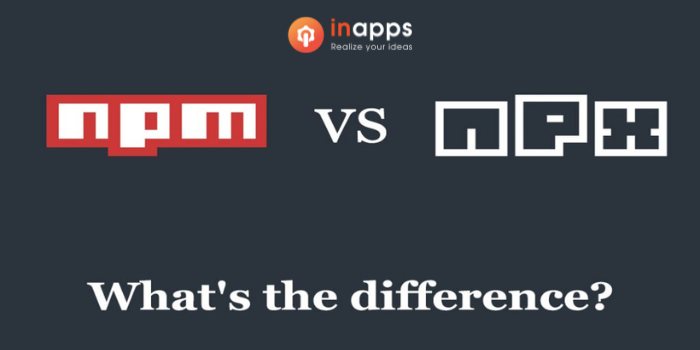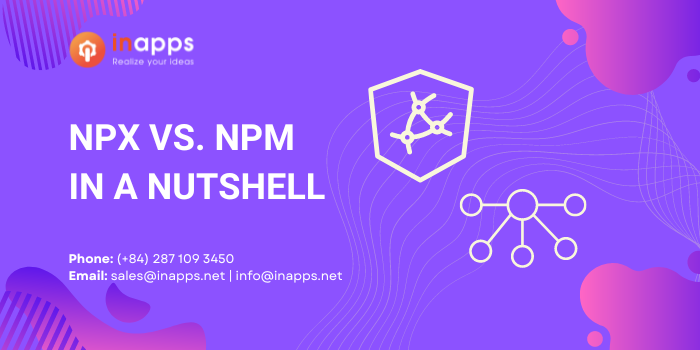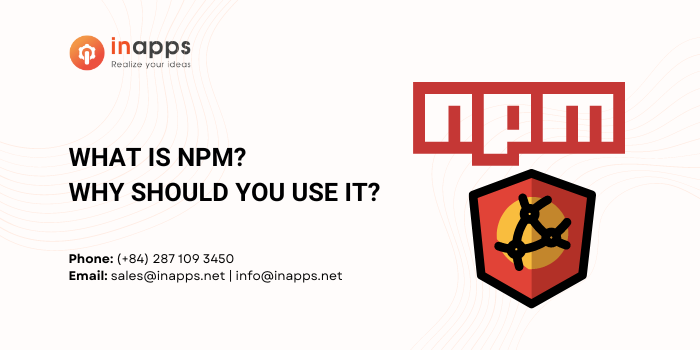- Home
- >
- Mobile apps development
- >
- NPX vs NPM in a nutshell
If you have ever worked around with JavaScript, then you must have probably heard about NPM, and NPX. You have may have made use of them to install something. In this article, we will demonstrate to you what they are, the differences between NPX vs NPM, and the many factors it entails.
Now, before diving straight into having an NPX vs NPM comparison, let us first understand each one of them individually. One of the most fascinating, prominent, and popular languages out there undoubtedly is JavaScript. So, anytime there’s a new term floating around in the programming world, it’s probably JavaScript related. NPX is one such buzz phrase.
NPM is Node.js’s package manager, and is used to install and save Node.js packages. It works by downloading the package (either from a remote repository or from a CDN) and then stores them in the directory automatically, that way it can then be accessed later on for installation.
NPM comes with an extensive collection of built-in modules, but there are plenty of other modules available as well for download!
On the other hand, What is NPX? It’s basically short for Node Package Execute and comes with npm, which automatically installs npx when you have installed npm above 5.2.0. It’s an npm package runner that can run any package from the command line.
NPX, otherwise known as Node Package Execute, is a package runner that can run any package from the npm registry. It has been out since March 2017 and is simple to use with no configuration needed, thanks to it being an npm package runner.
However, you have to make sure that you do not get confused with similar stuff out there. In such a case, we would like to clarify briefly what Node and NPM are and how they differ.

Key Summary
- Overview: The article by InApps Technology explains the differences between NPX and NPM, two tools in the Node.js ecosystem, highlighting their purposes, functionalities, and use cases to help developers choose the right tool for their projects.
- What is NPM?:
- Definition: Node Package Manager (NPM) is the default package manager for Node.js, used to install, manage, and share JavaScript packages and dependencies.
- Primary Functions:
- Installs packages locally (npm install <package>) or globally (npm install -g <package>).
- Manages project dependencies via package.json.
- Runs scripts defined in package.json (e.g., npm run build).
- Use Case: Setting up a project with dependencies like Express or React by installing them into the project’s node_modules folder.
- Example: npm install express adds Express to the project for building a web server.
- Characteristics:
- Stores packages on the local machine, increasing disk usage.
- Requires manual updates to keep packages current.
- Ideal for long-term project dependency management.
- What is NPX?:
- Definition: NPX (Node Package Executor) is a tool bundled with NPM (since version 5.2.0) that executes Node.js packages without requiring local or global installation.
- Primary Functions:
- Runs packages directly from the NPM registry or a local path without installing them permanently.
- Executes one-off commands or scripts (e.g., CLI tools) by downloading packages temporarily.
- Simplifies running specific package versions or local binaries.
- Use Case: Running a tool like create-react-app once to bootstrap a project without cluttering the system with a global install.
- Example: npx create-react-app my-app creates a React project without installing create-react-app globally.
- Characteristics:
- Saves disk space by avoiding permanent installations.
- Automatically fetches the latest or specified package version.
- Ideal for one-time tasks or testing tools.
- Key Differences:
- Installation:
- NPM: Installs packages to node_modules or globally, requiring manual management.
- NPX: Executes packages without installation, caching them temporarily.
- Use Case:
- NPM: Managing project dependencies or frequently used tools.
- NPX: Running one-off commands, CLI tools, or experimenting with packages.
- Disk Usage:
- NPM: Consumes more disk space due to persistent storage.
- NPX: Minimal, as it clears temporary files after execution.
- Speed:
- NPM: Faster for repeated use since packages are pre-installed.
- NPX: May be slower initially due to downloading packages on demand.
- Examples:
- NPM: npm install -g nodemon to install nodemon globally for ongoing development.
- NPX: npx nodemon app.js to run nodemon once without installing it.
- Installation:
- Benefits:
- NPM: Ensures consistent dependency management for projects, supports script automation, and integrates with CI/CD pipelines.
- NPX: Simplifies workflows by eliminating global installs, reduces conflicts between package versions, and enhances flexibility for testing.
- Cost Efficiency: Offshore development in Vietnam ($20-$50/hour via InApps Technology) optimizes costs for Node.js projects using NPM/NPX workflows.
- Challenges:
- NPM: Global installations can lead to version conflicts or clutter; requires maintenance to update dependencies.
- NPX: Slower for repeated tasks due to on-demand downloads; relies on internet connectivity.
- Use Cases:
- NPM: Setting up a Node.js project with Express, React, or MongoDB drivers for long-term development.
- NPX: Running tools like eslint, webpack, or cowsay for quick tasks, migrations, or project initialization.
- InApps Technology’s Role:
- Provides expertise in Node.js development, leveraging NPM for dependency management and NPX for streamlined workflows.
- Utilizes Vietnam’s 200,000+ IT professionals, offering cost-effective rates ($20-$50/hour) for 20-40% savings compared to U.S./EU ($80-$150/hour).
- Supports Agile methodologies with tools like Jira and Slack for efficient project delivery.
- Recommendations:
- Use NPM for managing project dependencies and running recurring scripts in package.json.
- Use NPX for one-time executions, CLI tools, or testing packages without installation.
- Combine both tools in workflows: NPM for setup, NPX for ad-hoc tasks.
- Partner with InApps Technology for expert Node.js development, leveraging Vietnam’s skilled developers to optimize NPM/NPX-based projects.
What do we understand by NPM?
NPM is short for Node package manager and is known to be the largest software registry in the world. It is the default Node.js package manager. It is actually written in JavaScript and was originally released on 12th January 2010, by Isaac Z. Schlueter. For node.js, npm manages all packages and modules and comprises the npm command-line client.
Node is the platform that all webpages are built on. It is used to communicate between different servers with API’s and HTML, CSS, and JavaScript. Node never sends any data over the wire; everything is sent through an API call. The API call can be JSON or XML formatted.
Also with the installation of node.js, it gets installed into the system. In the Node project, the packages and modules needed are installed using npm. A package includes all the files required for a module, and JavaScript libraries are modules that would be included in the Node project as required by it.
You need to install Node.js to have npm installed on your system. A CLI that could be used to download and install packages is included with npm.
We first need to build package.json to begin to work with npm (this file contains much project-relevant metadata. The file is used to send npm data that enables the project to be defined and the dependencies of the project to be handled) by executing the following command:
npm init -yThis command generates the package.json file with the default configuration in the current directory since we made use of the -y flag. We may run the following command to add packages from the npm registry:
npm i eslintFeatures of NPM
We all use NPM in one way or the other, be it for installing AngularJS modules, Babel, Gulp or even TypeScript. But what do we understand by NPM? Let’s find out! Npm comprises of 3 major aspects:
- The website
- The Command Line Interface (CLI)
- The registry
What is NPM used for?
NPM is a package manager for the JavaScript programming language. It is an open-source project started by Isaac Schlueter in 2009 and since then has been used as the default package manager for Node.js. In this part, we discuss what NPM is and how it works to help you learn more about why it’s such a popular tool:
- Adjust code packages for your programs, or integrate packages as they are.
- Install independent software that you can instantly use.
- Operate packages using npx without downloading.
- Share the code with any user of npm, anytime.
- Restrict individual developers to code.
- Build organizations to coordinate managing, coding, and creators of packages.
- By using organizations, shape virtual teams.
- Several code versions and code dependencies are handled.
- Easily upgrade software by upgrading the underlying code.
- Discover different ways of solving the same puzzle.
- Find other developers who are working on issues and projects that are similar.
What do we understand by NPX?
Npx is a package runner. It can be used to run any package installed in your node_modules directory. The point of it is that it does not require you to install the package globally to be able to use it – you just need to type npx plus the name of the package.
Npx is basically short for Node Package Execute and comes with npm, which automatically installs npx when you have installed npm above 5.2.0. It’s an npm package runner that can run any package from the npm registry that you like without even downloading that package.
It’s an npm package runner that can run any package from the npm registry that you like without even installing that package. The npx is beneficial for a single package of time consumption.
NPX is also a CLI application intended to enhance the experience of using the npm registry packages (npm version 5.2.0 NPXis pre-bundled with npm – tnx StefanT123 ). It is simple to run any kind of Node.JS-based executable with NPX. Let’s look at some examples:
We have two options for implementing Eslint:
./node_module/.bin/eslint --initSince all the executable nodes in the .bin directory running the above command are not so user-friendly, we can make use of npx: instead which can work in a better way for us.
npx eslint --initWhen you do not wish to use NPX for any reason, you can install eslint globally:
npm install -g eslint
The package will now be installed in node modules in the user directory of your computer, which ensures that you can execute eslint globally in any directory.

How to update NPX?
Features of NPX
Npx can be used to quickly and easily execute any and all npm packages. It also provides an alternative to using the long NPX- or NPM-specific commands that we’ve been using up until now.
The nice thing about npx is that it runs as a separate process, meaning that any errors don’t stop other tasks from working as expected. Let us see some of the features of NPX:
- Simple and quick to run local commands.
- Allows running commands without first installing them.
- Runs some code using a different Node version.
- Runs arbitrary code snippets directly from a URL.
- You can execute npx commands with $npm_ Environment Variables.
- You can also execute Code from a Remote GitHub Branch with npx.
- NPX is also used to execute code from a GitHub gist.
What is the Advantage of NPX?
You can save yourself storage space and actually run them with npx when you really need it instead of downloading node executable packages worldwide that you are likely to use less frequently. This means that any node executable package on the npm registry can be used with the installation necessary.
You don’t need to install create-react-app globally on your computer and may not have to worry regarding updates since npx will still try looking up the npm registry and run the create-react-app with its latest version whenever you run npx create-react-app.
Installing npm packages globally a lot of times needs sudo. With npx, you can easily execute a node executable anywhere without sudo.
When you just want to give it a whirl, you don’t have to install a CLI tool from the npm registry.
npx <package/command>You may also use npx to run your scripts without adding $PATH variables.
npx ./my-script.js
Intriguingly, you may mix npx powers with an executable node package in the npm registry that installs a binary node into your project (so that you can provide a local version of a node that is different from that of your device and handle the node as a standard dependency) much like nvm.
You can run commands that have various versions of Node.js with this mixture.
NPX vs NPM: The Difference
The following difference between NPX & NPM will make things even more clear to you. The difference will point out how each one of them is different from the other. Let us go ahead and see how both of them are different from each other:
| NPM | NPX |
| You need to define this package in your package.json and install it locally if you want to run the package through npm. | A package may be executable without downloading a program, it is an npm package runner. So if any packages are not really installed, it will be installed automatically. |
| If you want to make use of create-react-app in npm, the commands are npm install create-react-app then create-react-app myApp. | However, in npx, you can use this command only once in the life cycle of each app, before installing it like npx create-react-app myApp. |
| Npm is a tool that is used to install packages. | Npx is a tool that is used to execute packages. |
| Packages used by npm are widely installed so you have to take care of emissions in the long run. | Packages used by npx are not installed on a global level so you don’t have to worry about the pollution in the long run.. |
In A Nutshell…

Till now all of us might have gotten an idea that npm is a Node.js package manager whose purpose is to handle automated dependencies and packages.
This implies that we may specify all our dependencies (packages) for a project in the package.JSON file and when anyone has to install the dependencies, they can simply run npm install and they will get what they are exactly looking for.
It also offers versioning, i.e. it allows us to define which versions of the dependencies the project relies on so that we can avoid changes from destroying our project or using our preferred version for the most portion.
Whereas, npx is a Node package execution tool and comes bundled with npm beginning with npm5.2 version onward.
Summing up what NPX really does:
- By definition, it first tests if the executable package is present in the path (that is, in our project).
- It executes it if it does.
- Otherwise, it implies that the package was not installed, so npx downloads the new version of the package and then runs it.
This behavior is the default one for npx but it has certain flags that can be made to use to prevent it. For instance, if we run some-package npx —no-install indicates we’re telling npx that we must only try to run a package called some-package, without having to install it if it was never made to install before.
FAQ’s
What is the importance of NPX?
NPX is also a CLI application intended to enhance the experience of using the npm registry packages (npm version 5.2.0 NPXis pre-bundled with npm – tnx StefanT123 ). It is simple to run any kind of Node. JS-based executable with NPX.
What is the importance of NPM?
NPM is short for Node package manager and is known to be the largest software registry in the world. It is the default Node.js package manager.
What is the prime comparison between NPX and NPM?
While If you want to make use of create-react-app in npm, the commands are npm install create-react-app then create-react-app myApp. However, in npx, you can use this command only once in the life cycle of each app, before installing it like npx create-react-app myApp.
How to use NPX?
To use NPX, you would run a command like this:
npx some-packageOne great way for you to see how quickly NPX works is to create a react app using:
$ npx create-react-app my-appThe above command will generate a react app, named my-app, in the path that the command was run in using the create-react-app package. NPX then searches for the package in your environment. If it is not found, NPX downloads the files and runs the command to create a new react app, using just that one line of command.
Lastly, if ever you feel the need to learn more about technologies, frameworks, languages, and more – InApps will always have you updated.
[sociallocker id=”2721″]
[/sociallocker]
Let’s create the next big thing together!
Coming together is a beginning. Keeping together is progress. Working together is success.



















